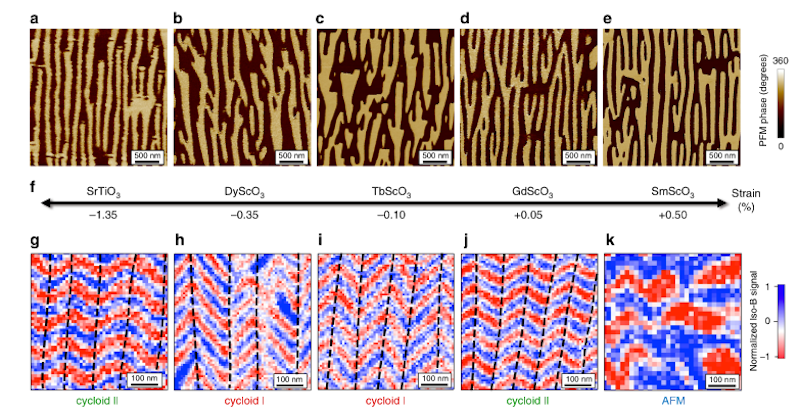Antiferromagnetic textures in BiFeO3 controlled by strain and electric field
A. Haykal et al, Nature Communications 11, 1704 (2020) get the file
This work results from a collaboration between the Laboratoire Charles Coulomb in Montpellier, France, the Unité Mixte de Physique CNRS/Thales in Palaiseau, France, the SPEC in Gif-sur-Yvette, France, the University of New South Wales in Sydney, Australia, the University of Twente in Enschede, the Netherlands and the synchrotron SOLEIL in Gif-sur-Yvette, France.
We studied thin films of bismuth ferrite (or short BFO) with varying epitaxial strain. BFO is indeed an antiferromagnet which also possess an electric polarization (a multiferroic) and the coupling between the magnetic and the electric state is strain-dependent. This mechanism could therefore provide a solution for low-power control antiferromagnetic states.
We prepared a serie of BFO films undergoing various strains by changing the growth substrate and then used a combination of several experimental techniques to characterize and manipulate their magnetic and electric states:
- NV center magnetometry to image the antiferromagnetic state
- Piezoresponse force microscopy (PFM) to determine the direction of the electric polarization
- Resonant elastic X-ray scattering to confirm the properties of the magnetic states in reciprocal space.

Our data reveal the presence of two types of cycloids modulating the antiferromagnetic order. At low strain, we observe the same cycloidal state as in bulk BFO but when the strain (either compressive or tensile) increases, a second cycloid type propagating along another direction is stabilized. When the strain becomes too large, the cycloid disappear and only antiferromagnetic domains remain. This observation of two types of cycloid, the usual one from the bulk and an exotic one, is supported by resonant x-ray scattering measurements.

We went further and used the PFM tip to written single ferroelectric domains. Our NV magnetometry measurements show that the cycloid can be stabilized or that its type can be modified using this procedure, and consequently demonstrate that efficient control of the spin cycloid can be achieved electrically.